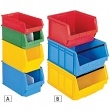 When it comes to bin & container storage, there are thousands of options available. Here is a brief overview of several different types of storage bins and containers that.
When it comes to bin & container storage, there are thousands of options available. Here is a brief overview of several different types of storage bins and containers that.
Storage Bin Types
Stacking Bins: These storage bins stack on each other to save room on shelving or in cabinets. They will hang on panels or rails and can be divided to accommodate different parts in one container.
Shelf Bins: Used on shelving or in cabinets. Not designed to hang on leveled panels or rails. If necessary, shelf bins can be divided.
Container Types
Straight-Wall Containers: Provide the most cubic space to hold more product/material during storage or transport. Outstanding stacking ability for secure storage. Is able to be palletized to generate unitized shipping loads. These containers feature smooth, flat walls.
Stack and Nest Containers: Stack the containers when they are full. Nest when they are empty for efficient use of space in truck trailers or distribution centers. Come with a choice of attached or detached covers.
Attached Lid Containers: Attached lids are an option for tidiness and security. Lids are attached with durable hinges to stay on the container always. Can be used to hide contents from view.
Detached Lid Containers: Lids are separate from container and fit tightly on container. Use to help keep contents clean. Stack with lids.
Divided Boxes: Dividers allow for compartmentalizing. Stackable lids are available, as well. Can be used to separate parts and keep them from possible damage.
Source: Rack Express Catalog (p 159)

Thanks for the informative blog. Warehouse Storage Bins that are of different use in accordance with the type of storage materials. These storage bins help to keep each material separately and systematically.
When carried by rail, containers may be carried on flatcars or well cars. The latter are specially designed for container transport, and can accommodate double-stacked containers. However, the loading gauge of a rail system may restrict the modes and types of container shipment. The smaller loading gauges often found in European railroads will only accommodate single-stacked containers. In some countries, such as the United Kingdom, there are sections of the rail network through which high-cube containers cannot pass, or can pass through only on well cars. On the other hand, Indian Railways runs double-stacked containers on flatcars under 25 kV overhead electrical wires. The wires must be at least 7.45 metres (24 ft 5 in) above the track. China Railway also runs double-stacked containers under overhead wires, but must use well cars to do so, since the wires are only 6.6 metres (21 ft 8 in) above the track.